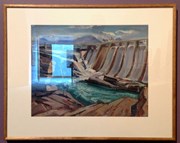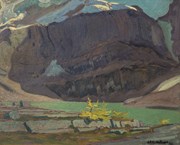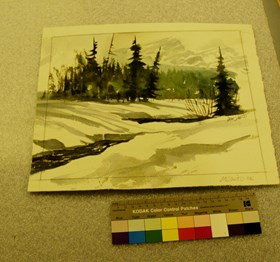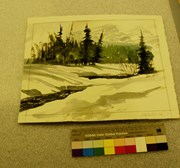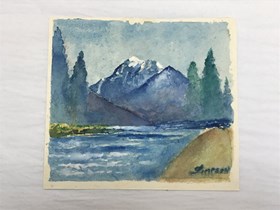Narrow Results By
- James (Sr.) Simpson (1877 – 1972, Canadian) 7
- Sandford, Robert W. 2
- Bern Smith (1928 – 2009, Canadian) 1
- Coleman, Diane 1
- Fluker, Shaun 1
- George Douglas Pepper (1903 – 1962, Canadian) 1
- Gray, Kim 1
- James Edward Hervey MacDonald, R. C. A. (1873 – 1932, Canadian) 1
- Legault, Stephen 1
- Ommanney, C. Simon L. 1
- Sandford, Robert W 1
- Van Tighem, Brian 1
- Date
- 1947 – 1947
- Medium
- oil on canvas
- Catalogue Number
- PeG.02.03
- Description
- Brown and blue slate rock in the foreground with one lone stilted tree to the left; rocks are higher on the left almost meeting the walkway on the top of the dam. Lower mid-centre of the painting is the mass of swirling green, blue and white water rushing from the gates of the falls. The grey gates…
1 image
- Title
- Dam Falls
- Date
- 1947 – 1947
- Medium
- oil on canvas
- Dimensions
- 40.5 x 51.0 cm
- Description
- Brown and blue slate rock in the foreground with one lone stilted tree to the left; rocks are higher on the left almost meeting the walkway on the top of the dam. Lower mid-centre of the painting is the mass of swirling green, blue and white water rushing from the gates of the falls. The grey gates with water rushing down are mid-centre to the right. The walkway on the top of the dam extends throughout top-half of the painting. An outline of a rider and two horses are off to centre right, top of a mauve mountain behind and cloudy blue sky.
- Credit
- Gift of Moore Gallery Ltd, Hamilton, 1995
- Catalogue Number
- PeG.02.03
Images
This material is presented as originally created; it may contain outdated cultural descriptions and
potentially offensive content.
Read more.
Fortress Mountain and the false promise of public participation in Alberta
https://archives.whyte.org/en/permalink/catalogue25149
- Medium
- Library - Periodical
- Published Date
- March 2020
- Author
- Fluker, Shaun
- Publisher
- The Alberta Wilderness Association Journal
- Call Number
- P
1 website
- Author
- Fluker, Shaun
- Responsibility
- Shaun Fluker
- Publisher
- The Alberta Wilderness Association Journal
- Published Date
- March 2020
- Physical Description
- p. 6 - 8
- Medium
- Library - Periodical
- Subjects
- Kananaskis
- Kananaskis Country
- Kananaskis Lakes
- Water
- Watersheds
- Hydrology
- Hydrology - Alberta
- Abstract
- Pertains to the application by Fortress Mountain Ski Hill for an amendment to its water license which would allow for 50 million litres of water annually to be removed and bottled
- Notes
- In Wildlands Advocate, Vol. 28, No.1, March 2020
- Call Number
- P
- Collection
- Archives Library
- URL Notes
- PDF of publication can be downloaded on Alberta Wilderness' website
Websites
This material is presented as originally created; it may contain outdated cultural descriptions and
potentially offensive content.
Read more.
Glacier surveys by district personnel of the Water Survey of Canada. 1, The Victoria glacier
https://archives.whyte.org/en/permalink/catalogue24962
- Medium
- Library - Book (including soft-cover and pamphlets)
- Published Date
- 1971
- Author
- Ommanney, C. Simon L.
- Publisher
- Ottawa : Inland Waters Branch, Dept. of the Environment
- Call Number
- 03.4 O1g
- Author
- Ommanney, C. Simon L.
- Responsibility
- C. Simon L. Ommanney
- Publisher
- Ottawa : Inland Waters Branch, Dept. of the Environment
- Published Date
- 1971
- Physical Description
- v, 18 pages : illustrations, maps
- Series
- Glacier Inventory Note No. 6
- Abstract
- Pertains to the
- Contents
- Introduction
- Description
- Surveyors
- Snout Activity
- Surface Movement
- Discharge
- Diagrams
- Photographs
- Bibliography
- Notes
- Errata slip inserted
- Accession Number
- 2019.96
- Call Number
- 03.4 O1g
- Collection
- Archives Library
This material is presented as originally created; it may contain outdated cultural descriptions and
potentially offensive content.
Read more.
Heart waters : sources of the Bow River
https://archives.whyte.org/en/permalink/catalogue25255
- Medium
- Library - Book (including soft-cover and pamphlets)
- Published Date
- 2015
- Author
- Van Tighem, Kevin
- Van Tighem, Brian
- Publisher
- [Victoria, British Columbia] : Rocky Mountain Books
- Edition
- First
- Call Number
- 03.5 V26h
1 website
- Responsibility
- Kevin Van Tighem (author)
- Brian Van Tighem (photographer)
- Edition
- First
- Publisher
- [Victoria, British Columbia] : Rocky Mountain Books
- Published Date
- 2015
- Physical Description
- 256 pages : colour illustrations, colour maps
- Abstract
- Water does not come from the river. It comes to the river. Heart Waters takes us to the sources of that water – and into the living beauty, human stories and future possibilities that also arise from the green uplands and valleys of Alberta’s Eastern Slopes, where the mighty Bow River is born. For more than a century the foothills and Front Range mountains of western Alberta have been recognized as being vital to the water supply for western Canada. Virtually all the water that sustains communities, ecosystems and the economy of prairie Canada comes from this narrow strip of land arrayed along the Continental Divide. For all its importance, however, water management decisions affecting this enormous region have ignored the significance of land health and focused almost exclusively on building dams. The result, as the author points out, is that the Bow River’s annual flows have decreased by more than a tenth, even as spring floods become more frequent and more destructive. The solutions to prairie Canada’s water challenges lie in healing the wounded landscapes of our headwaters. Heart Waters delves deeply into the history and ecology of a landscape whose critical value as a watershed is matched by its sheer beauty and diversity. A rich array of stunning images by Jasper-based photographer Brian Van Tighem complements the author’s well-researched explorations of the stories whispered by the living waters that drain from Banff National Park, Kananaskis Country and the famous ranchlands of the Bow River watershed. Kevin Van Tighem’s latest book is a deep exploration of place and an invitation to recognize that our water future depends upon knowing our headwaters better and caring for them more passionately — as our heart waters. (from publisher's website)
- Contents
- 1. Voices in the water -- 2. River origins: Bow River -- 3. A prodigal's return: Johnson Creek -- 4. Caterpillars and cutthroats: Quirk Creek -- 5. The past and future trout: Meadow Creek -- 6. Lake of the spirits: Cascade River and Ghost River -- 7. Dammed splendor: Kananaskis River -- 8. Buck-toothed volunteers: Bateman Creek -- 9. The under-river: Middle Bow River -- 10. Water and wildness: Sheep River -- 11. Cattle in the creek: Pekisko Creek -- 12. Mountains breathing: Highwood River -- 13. Healing the headwaters -- 14. Home and heart waters -- Index.
- Notes
- Shortlisted for the 2016 Banff Mountain Film and Book Festival award for Mountain & Wilderness Literature
- ISBN
- 9781771601399
- Accession Number
- P2020.07
- Call Number
- 03.5 V26h
- Collection
- Archives Library
- URL Notes
- Publisher's website
Websites
This material is presented as originally created; it may contain outdated cultural descriptions and
potentially offensive content.
Read more.
- Date
- 1927
- Medium
- oil on board
- Catalogue Number
- MaJ.02.03
- Description
- The shore of Lake Oesa is visible in the foreground at the bottom of the painting. It is quite rocky. A small shrub or plant is sprouting out of the rock on the right side of the shore. The turquoise Lake Oesa stretches across the canvas. The lake meets up with the headwall of the glacier which …
1 image
- Title
- Lake Oesa
- Date
- 1927
- Medium
- oil on board
- Dimensions
- 26.0 x 20.6 cm
- Description
- The shore of Lake Oesa is visible in the foreground at the bottom of the painting. It is quite rocky. A small shrub or plant is sprouting out of the rock on the right side of the shore. The turquoise Lake Oesa stretches across the canvas. The lake meets up with the headwall of the glacier which forms the upper half of the painting. It is painted in shades of dark blue and purple. At the top of the painting, blue and white areas of the glacier are visible.
- Subject
- landscape
- water
- Canadian Rockies
- Lake Oesa
- Credit
- Gift of George K.K. (Tommy) Link, Tucson, USA, 1979
- Catalogue Number
- MaJ.02.03
- Notes
- Artistry Revealed: Peter Whyte, Catharine Robb Whyte and Their Contemporaries; June 17, 2018 to October 21, 2018
Images
This material is presented as originally created; it may contain outdated cultural descriptions and
potentially offensive content.
Read more.
Man on water - water almost claimed Bob Sandford's life, so why has the Alberta scientist devoted his entire career to saving the planet's most precious resource?
https://archives.whyte.org/en/permalink/catalogue25115
- Medium
- Library - Periodical
- Published Date
- April 2009
- Author
- Gray, Kim
- Publisher
- Canadian Living
- Call Number
- P
- Author
- Gray, Kim
- Responsibility
- Kim Gray (author)
- George Webber (photographer)
- Publisher
- Canadian Living
- Published Date
- April 2009
- Physical Description
- p. 164 - 173
- Medium
- Library - Periodical
- Abstract
- Pertains to Bob Sandford's work in the Canadian Rocky Mountains with water conservation
- Notes
- In Canadian Living, Vol. 34, No.4, April 2009 pg. 164-173
- Call Number
- P
- Collection
- Archives Library
This material is presented as originally created; it may contain outdated cultural descriptions and
potentially offensive content.
Read more.
Mosquito Creek
https://archives.whyte.org/en/permalink/artifactsmb.05.04
- Date
- 2009
- Medium
- watercolour on paper
- Catalogue Number
- SmB.05.04
- Description
- A winter scene with dominant colours of white, green, blue, grey, and black. The foreground, which is more than half the painting, is comprised of snow, ice, shadows, two sections of the creek starting from viewer’s left, with one bush and one coniferous tree to viewer’s far middle right. The dark …
1 image
- Title
- Mosquito Creek
- Date
- 2009
- Medium
- watercolour on paper
- Dimensions
- 30.0 x 36.7 cm
- Description
- A winter scene with dominant colours of white, green, blue, grey, and black. The foreground, which is more than half the painting, is comprised of snow, ice, shadows, two sections of the creek starting from viewer’s left, with one bush and one coniferous tree to viewer’s far middle right. The dark water of the creek is visible from the bush at the right, flows under the ice and snow, and then reappears at the left-hand centre of the painting and flows to the viewer’s left hand corner of the painting. The top-third of the painting is a bank of coniferous trees, sparsely painted on the left, becoming larger and darker towards middle and then lighter on the right as the trees further back rise to the mountain range in the background. Snow and clouds obscure the mountain tops. The sky is light grey and white.
- Credit
- Purchased from Brett Smith, 108 Mile Ranch, 2009
- Catalogue Number
- SmB.05.04
Images
This material is presented as originally created; it may contain outdated cultural descriptions and
potentially offensive content.
Read more.
Mount Temple, Canadian Rockies
https://archives.whyte.org/en/permalink/artifactsij.05.09
- Date
- 1972
- Medium
- watercolour on paper
- Catalogue Number
- SiJ.05.09
- Description
- Colour: blue, green, brown. Lower half is water on the left and a brown shore in the lower right corner. Yellow grass grows at the left side of the far shore. Two trees go up the left side. Three go up on the right. The upper half is a mountain at center. Blue sky above.
1 image
- Title
- Mount Temple, Canadian Rockies
- Date
- 1972
- Medium
- watercolour on paper
- Dimensions
- 20.4 x 23.8 cm
- Description
- Colour: blue, green, brown. Lower half is water on the left and a brown shore in the lower right corner. Yellow grass grows at the left side of the far shore. Two trees go up the left side. Three go up on the right. The upper half is a mountain at center. Blue sky above.
- Subject
- landscape
- Canadian Rockies
- mountain
- water
- Credit
- Gift of Gus (Mrs.) Baracos, Banff, 1978
- Catalogue Number
- SiJ.05.09
Images
This material is presented as originally created; it may contain outdated cultural descriptions and
potentially offensive content.
Read more.
MOUNTAINS TO METROPOLIS : the elbow river watershed
https://archives.whyte.org/en/permalink/catalogue25262
- Medium
- Library - Book (including soft-cover and pamphlets)
- Published Date
- 2015
- Author
- Coleman, Diane
- Publisher
- [Place of publication not identified], FRIESENPRESS
- Call Number
- 03.5 C67m
- 03.5 C67m reference copy
1 website
- Author
- Coleman, Diane
- Responsibility
- Diane Coleman
- Publisher
- [Place of publication not identified], FRIESENPRESS
- Published Date
- 2015
- Physical Description
- 261 pages
- Subjects
- Rivers
- Water
- Watersheds
- Hydrology
- Hydrology - Alberta
- Abstract
- Every watershed has a story: this is the Elbow’s. The Elbow River watershed is a small yet significant watershed extending from the Front Ranges of the Rocky Mountains to downtown Calgary. This geographical watershed is itself at a metaphorical watershed, due to increasing pressure for urban, industrial and recreational development which will alter the healthy functioning of its interdependent parts. Mountains to Metropolis combines the author’s own explorations in the watershed with comprehensive background information to place the reader in the watershed itself. Grizzly bears and mule deer, park wardens and cowboys, First Nations and first settlers, range cattle and coyotes, urbanites and beavers, city engineers and soldiers, Grey Nuns and missionaries – all are part of this watershed’s story. And each has shaped and been shaped by the physical and spiritual power of the river at the watershed’s core. While legislators, municipal managers, industry and residents all have a responsibility for making our watershed happy and healthy, in the end it comes down to the individual. The author lays out simple actions that we each can take in our daily lives. (from publisher's website)
- Contents
- Preface -- Acknowledgements -- Introductions -- Part 1. In the high mountains -- Part 2. The Foothills between -- Part 3. To plains and metropolis -- Part 4. Whither the Elbow -- Appendices: 1. Historical timeline: Elbow River watershed and region ; 2. Scientific names.
- ISBN
- 9781460271155
- Accession Number
- P2020.07
- 2024.26
- Call Number
- 03.5 C67m
- 03.5 C67m reference copy
- Collection
- Archives Library
- URL Notes
- Publisher's website
Websites
This material is presented as originally created; it may contain outdated cultural descriptions and
potentially offensive content.
Read more.
Our vanishing glaciers : the snows of yesteryear and the future climate of the mountain West
https://archives.whyte.org/en/permalink/catalogue25256
- Medium
- Library - Book (including soft-cover and pamphlets)
- Published Date
- 2017
- Author
- Sandford, Robert W.
- Publisher
- [Victoria, British Columbia] : Rocky Mountain Books
- Edition
- First
- Call Number
- 03.4 Sa5o
1 website
- Author
- Sandford, Robert W.
- Responsibility
- Robert W. Sandford
- Edition
- First
- Publisher
- [Victoria, British Columbia] : Rocky Mountain Books
- Published Date
- 2017
- Physical Description
- 223 pages : illustrations (chiefly color), maps (chiefly color)
- Subjects
- Water
- Watersheds
- Rivers
- Glaciers
- Hydrology
- Hydrology - Alberta
- Rocky Mountains
- Climate change
- Abstract
- Written by one of the most respected experts in water and water-associated climate science and featuring stunning photography collected over the past four decades, Our Vanishing Glaciers explains and illustrates why water is such a unique substance and how it makes life on this planet possible. Focusing on the Columbia Icefield, the largest and most accessible mass of ice straddling the Continental Divide in western North America, and featuring photographs, illustrations, aerial surveys and thermal imaging collected over more than 40 years of the author’s personal observations, the book reveals the stunning magnitude of glacial ice in western Canada. Citing evidence to suggest that in the Canadian Rocky Mountain national parks alone, as many as 300 glaciers may have disappeared since 1920, this large-format, fully illustrated coffee table book graphically illustrates the projected rate of glacier recession in the mountain West over the rest of this century and serves as a profound testament to the beauty and importance of western Canada’s water, ice and snow. (from publisher's website)
- Contents
- 1. The wonder of water -- 2. What winter does to water -- 3. Ecology as defined by winter water -- 4. How ice fields and glaciers form -- 5. Canada's most accessible glaciers -- 6. The death of Peyto glacier : A case for more comprehensive -- 7. The Columbia ice field today -- 8. Glaciers in a changing climate -- 9. What we stand to lose -- 10. Water, climate and the National Parks ideal.
- Notes
- Winner, 2017 Lane Anderson Award for Best Canadian Science Writing
- ISBN
- 9781771602020
- Accession Number
- P2020.07
- Call Number
- 03.4 Sa5o
- Location
- Reading Room
- Collection
- Archives Library
- URL Notes
- Publisher's website
Websites
This material is presented as originally created; it may contain outdated cultural descriptions and
potentially offensive content.
Read more.


